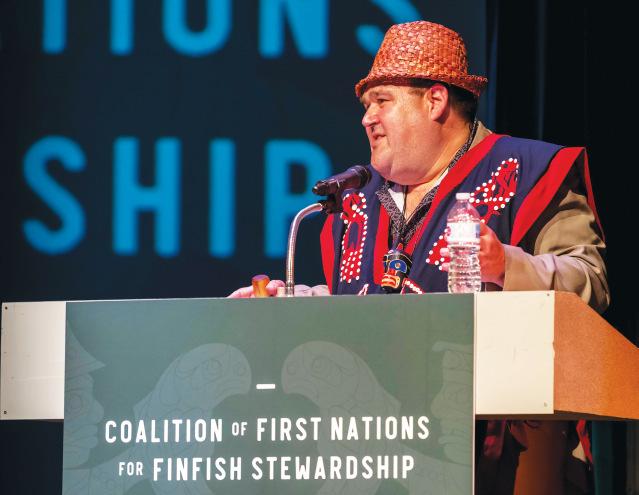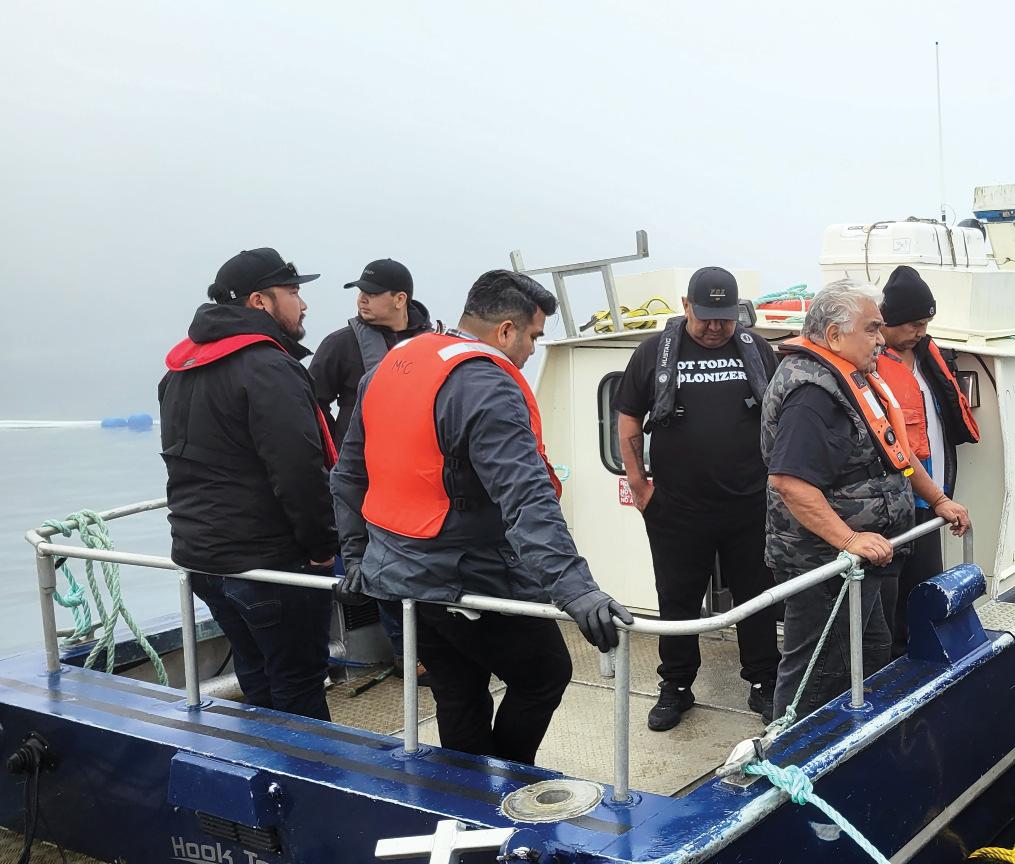
4 minute read
New technology separates farmed salmon from wild stocks,
A federal mandate to transition from ocean net pens by 2025 is losing meaning as First Nations rights, West Coast economics
By Eric Plummer Ha-Shilth-Sa Editor
Advertisement
Vancouver Island, BC -After a disappointing first trial, the second batch of fish being raised in a semi-closed system in Ahousaht territory is “exceeding expectations”, raising hope that the technology will add another stage to salmon farming that removes contact between farmed and wild stocks.
Cermaq has overseen theAtlantic salmon at its Millar Channel site for more than three months since the trial began in the fall. Known as semi-closed containment, the site differs from the traditional net pens by using an enormous bag composed of a synthetic non-permeable material that blocks out the surrounding ocean. Manufactured in Norway and assembled at Port Alberni’s Canal Beach, the semi-closed site is expected to keep the salmon until May. At that point Cermaq plans to move them to a traditional net pen in another Clayoquot Sound location, where the fish will remain for another 10 months until reaching harvest weight.
Before being moved into the semi-closed site the salmon were raised in land-based hatcheries for 12 months, which follows Cermaq’s usual practice of rearing fish. Oxygen and water are pumped into the ocean site from a depth of 23 metres, and so far lice have not been detected in the fish, avoiding an ongoing challenge in salmon farming.
“At 23 metres we don’t anticipate to find things that you’ll find at the top of the water like sea lice and other harmful plankton species,” said David Kiemele, managing director of Cermaq Canada, who hopes the semi-closed containment technology will become the first stage of the salmon’s time in the ocean. “At the first six to eight months at sea we can avoid the need to mechanically delouse the fish, and also improve on growth and survival during that period as well.”
This is Cermaq’s second trial of using the semi-closed system in Millar Channel, after the first run that started in the fall of 2020 yielded fish that were too small to sell.
“The first trial didn’t go as well as we would have hoped, but like anything new and innovative, there’s a bit of a learning curve,” admitted Kiemele. “Those fish didn’t make it to the actual harvest weights that we wanted to achieve, we had to pull the plug on the trial early. The fish were only about 1.5 to two kilos when we ended the trial.”
Technology gives more control
Despite the challenges of learning how to harness the new technology, semi-closed containment gives aquaculture operators more control over the environment salmon are farmed in, including artificially maintaining oxygen and keeping temperatures more consistent through the year.
“We inject oxygen into the bag, that takes out the normal fluctuations that you’ll see in the marine environment,” said Kiemele. “Warmer water during the winter and consistent oxygen are two key things for better growth.”
But this comes at a higher cost than net pens, requiring a significant investment if operators are to make semi-closed containment an integral part of salmon farming in the future. To make the practice more sustainable Cermaq is exploring the use of hydroelectric power generated at the farms instead of diesel.
“It boils down to reducing interaction between the environment and the farm, which has a number of benefits for not only our fish but also the environment and the wild fish in the area,” said Kiemele of semiclosed containment. “We want to be here long-term, and this could be part of how we achieve that.”
‘Wild salmon don’t have time to wait’
Salmon farming continues to face considerable opposition, a distrust of the practice that the Liberals addressed during the last federal election with a pledge to transition away from ocean-based net pens. Now Fisheries Minister Joyce Murray is working under a mandate “to create a responsible plan to transition from open net pen salmon farming in coastal British Columbia waters by 2025.”
“Wild salmon don’t have time to wait while the salmon farming industry tinkers with experimental technologies. Government must require the industry to get out of the ocean – by 2025 at the latest.”
For groups like ClayoquotAction, this change couldn’t come soon enough.
“It is clear that open-net pens are harm- ing wild salmon by spreading deadly pathogens, parasites and pollution,” wrote Executive Director Dan Lewis in a press release issued in October. “Wild salmon don’t have time to wait while the salmon farming industry tinkers with experimental technologies. Government must require the industry to get out of the ocean – by 2025 at the latest.”
In late September of last year the Union of B.C. Indian Chiefs passed a resolution urging a “rapid transition” away from oceanbased net pens to land facilities.
“The containment of hundreds of thousands of fish effectively transfers the economic burden of managing fish waste to the environment and surrounding communities,” stated the BCUIC resolution, which ties fish farming to “salmon-related diseases and viruses, including heart and skeletal muscle inflammation (HSMI), piscine reo-virus (PRV), and tenacibaculum, and for hazardous levels of parasitic sea-lice impacting wild migratory juvenile salmon, and unnatural levels of predation targeting vulnerable herring stocks.”
‘Asacred responsibility’
But early this year federal and provincial departments published reports that minimise sea lice concerns and state that moving ocean pens to land facilities is unviable.
Arecent report commissioned by the B.C. Ministry ofAgriculture and Food examined the economics of entirely moving salmon farming to land, concluding that the recirculating aquaculture system (RAS) technology used in such facilities would require a total investment of $1.8 billion for the transition. Conducted by Counterpoint Consulting, the study states that for landbased fish farming, “Profitable production of market-size salmon at commercial scale remains elusive.”


